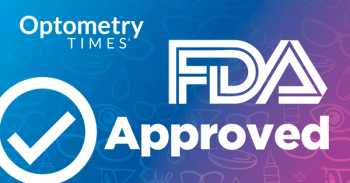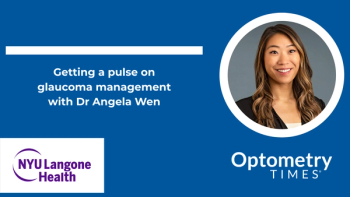
- September digital edition 2021
- Volume 13
- Issue 9
ODs are ignoring macular degeneration
Practitioners spend more time diagnosing glaucoma or diabetic retinopathy than AMD
Age-related macular degeneration (AMD) is the leading cause of irreversible blindness in adults older than 50 years. More than 11 million individuals are affected in the United Sates, a number expected to increase to 22 million by 2050.1 This is more than 3 times the number of individuals living with glaucoma (around 3 million2) and more than double the number living with diabetic retinopathy (DR; estimated 4.1 million3) in the United States.
However, eye care providers tend to spend less time diagnosing and treating AMD than they do glaucoma or DR. It is time to change that. New technologies for diagnosis and new management options have opened the path for ODs to help patients with this devastating disease.
Catching it early
Neovascular, or wet, AMD is responsible for nearly 90% of severe damage to central visual acuity and can be treated or at least mitigated with various anti-VEGF agents.4,5 However, an estimated 80% or more of patients with AMD have non-neovascular, or dry, AMD,6 for which there is no treatment. The difficult part for eye care providers is knowing how closely to monitor patients to catch the transition from dry AMD to wet AMD. Fortunately, eye care practitioners now have several tools to help.
The traditional means of checking for AMD is a dilated fundus examination to look for drusen or changes to the retinal pigmented epithelium (RPE). However, a level of discretion is required when interpreting physical changes. Although eye care practitioners can see drusen, they may not always know if the drusen are harbingers of AMD. Thus, if a patient with a family history of macular degeneration has signs of drusen or RPE remodeling, a dark adaptation test is recommended.7
Dark adaptation tests are functional tests, mimicking how eye care practitioners look for glaucoma. Although dark adaptation tests have been around for some time, earlier generations took so long to complete that they were not amenable to clinical practice. A newer rapid version (AdaptDx; MacuLogix) measures the number of minutes it takes for the eye to adapt from bright light to darkness, known as the rod intercept (RI) time. An RI of less than 6.5 minutes indicates impaired function with 90% sensitivity and specificity.8 The company’s latest iteration, AdaptDx Pro, uses a goggle-like mask that allows the test to be performed in any area of the clinic, no longer requiring a darkened room. In addition, a digital assistant guides the patient through the test, decreasing the demand on technicians.
In patients who already show signs of AMD, I strongly consider performing a genetic test to determine each patient’s individual risk of progression to advanced disease and subsequent vision loss. Arctic Dx and Visible Genomics offer tests that look at genetic markers and risk factors for progression in the short term and long term, which can then be used to tailor exam frequency for the patient.
Although dark adaptation tests can help ODs diagnose AMD earlier than clinical examination alone, and genetic testing can indicate the risk of progression, ODs are taking an educated guess on when they need to see the patient again. A patient can convert from dry AMD to wet AMD the day after an exam or any time in the 3- to 6-month period before their next exam. ForeseeHome (Notal Vision) helps to catch the transition by using hyperacuity perimetry to detect changes in macular metamorphopsia that would suggest conversion to neovascular AMD.
The advantage of ForeseeHome over an Amsler grid is that it is connected to a monitoring system that aids adherence. If the monitoring site notices that the patient is not testing with the ForeseeHome device, it contacts the patient to check on them, reminds them to test, and help them with problems they may be having. Because results from the test are automatically forwarded to the monitoring site, a clinical exam is scheduled immediately to see whether the patient has experienced disease progression if a change is detected. The sooner ODs can initiate treatment, the better the starting visual acuity and the better the patient will be in the long run. Results from the AREDS-2 HOME (NCT01103505) study showed that 50% more patients using ForeseeHome maintained visual acuity greater than 20/40 when compared with patients who used the Amsler grid alone.9
Proactive vs reactive disease management
Although it may seem that there is nothing ODs can do for patients with dry AMD, that is not the case. ODs know that lifestyle can have significant impact on AMD. Just as doctors do not wait for a cardiovascular patient to have a heart attack before advising the patient to improve cholesterol intake, ODs should not hesitate to discuss smoking with their patients with early AMD. ODs know that smoking increases the risk of AMD, and the odds ratio increases with a higher number of pack/year exposure.10,11 Fortunately, smoking cessation is associated with a reduced risk of AMD progression, making it an important modifiable risk factor. Unfortunately, nearly 90% of patients with AMD say they were never advised to quit smoking.12
Diet also matters. Individuals with a higher intake of saturated fats and cholesterol and those with a higher body mass index are also associated with an increased risk of AMD.13 Results from a 2018 study showed that adherence to a Mediterranean diet decreased the risk of advanced AMD by 41%, whereas eating red meat more than 10 times a week added an additional 46% risk of developing macular degeneration compared with those who ate red meat 5 times or less per week. Finally, results from the Beaver Dam study showed that people who exercise 3 or more times a week had a 70%
lower risk for late macular degeneration.14 It is worth considering these study results when discussing the disease with patients.
Finally, ODs know from the AREDS and AREDS 2 studies that antioxidant vitamins (ie, vitamin C, vitamin E), lutein, zeaxanthin, and zinc in an otherwise well-nourished population can slow the progression of intermediate AMD by approximately 25%.15,16
Although most eye care providers find it makes sense to start supplementation when patients have intermediate disease, I start supplementation with products such as OcularProtect (ScienceBased Health) or MacularProtect Complete (ScienceBased Health) earlier or, at a minimum, have the discussion with patients earlier. Patients are likely already taking a daily multivitamin—switching to one that also offers AREDS 2 levels of lutein and zeaxanthin to protect the macula makes sense.
If I see a patient who has mild to intermediate AMD and their genetic risk assessment shows them to be at very high risk of progression, I will schedule their follow-up appointments more frequently, counsel them more aggressively about lifestyle changes, and institute supplemental vitamin therapy earlier than I would have just based on clinical findings (Figures 1 and 2).
Conclusion
ODs have many tools in their armamentarium for patients with glaucoma. They can check intraocular pressure, corneal thickness, perform ocular coherence tomography and visual field testing, and check for disc cupping. ODs use all these methods because they don’t want to miss a patient who has glaucoma and allow it to progress.
It is time optometrists started thinking about patients with AMD in the same way. Rather than simply looking for drusen and declaring that a patient does or does not have macular degeneration, ODs must perform dark adaptation testing, obtain a more thorough family history, and consider genetic testing. ODs also need to be more forthright in discussing with patients lifestyle changes and nutritional supplementation. Optometrists now have clinical tools to make a difference for their patients with AMD; it is time to use them.
References
1. Wong WL, Su X, Li X, et al. Global prevalence of age-related macular degeneration and disease burden projection for 2020 and 2040: a systematic review and meta-analysis. Lancet Glob Health. 2014;2(2):e106-e116. doi:10.1016/S2214-109X(13)70145-1
2. Glaucoma: Facts & Figures. BrightFocus Foundation. Updated June 27, 2019. Accessed August 9, 2021. https://www.brightfocus.org/ glaucoma/article/glaucoma-facts-figures
3. Kempen JH, O’Colmain BJ, Leske MC, et al; Eye Diseases Prevalence Research Group. The prevalence of diabetic retinopathy among adults in the United States. Arch Ophthalmol. 2004;122(4):552-563. doi:10.1001/ archopht.122.4.552
4. Ambati J, Ambati BK, Yoo SH, Ianchulev S, Adamis AP. Age-related macular degeneration: etiology, pathogenesis, and therapeutic strategies. Surv Ophthalmol. 2003;48(3):257-293. doi:10.1016/s0039- 6257(03)00030-4
5. Ferris FL 3rd, Fine SL, Hyman L. Age-related macular degeneration and blindness due to neovascular maculopathy. Arch Ophthalmol. 1984;102(11):1640-1642. doi:10.1001/archopht.1984.01040031330019
6. Kahn HA, Leibowitz HM, Ganley JP, et al. The Framingham Eye Study. I. Outline and major prevalence findings. Am J Epidemiol. 1977;106(1):17- 32. doi:10.1093/oxfordjournals.aje.a112428
7. Higgins BE, Taylor DJ, Binns AM, Crabb DP. Are current methods of measuring dark adaptation effective in detecting the onset and progression of age-related macular degeneration? a systematic literature review. Ophthalmol Ther. 2021;10(1):21-38. doi:10.1007/ s40123-020-00323-0
8. Jackson GR, Scott IU, Kim IK, Quillen DA, Iannaccone A, Edwards JG. Diagnostic sensitivity and specificity of dark adaptometry for detection of age-related macular degeneration. Invest Ophthalmol Vis Sci. 2014;55(3):1427-1431. doi:10.1167/iovs.13-13745
9. AREDS2-HOME Study Research Group, Chew EY, Clemons TE, Bressler SB, et al. Randomized trial of a home monitoring system for early detection of choroidal neovascularization home monitoring of the eye (HOME) study. Ophthalmology. 2014;121(2):535-544. doi:10.1016/j. ophtha.2013.10.027
10. Khan JC, Thurlby DA, Shahid H, et al; Genetic Factors in AMD Study. Smoking and age related macular degeneration: the number of pack years of cigarette smoking is a major determinant of risk for both geographic atrophy and choroidal neovascularisation. Br J Ophthalmol. 2006;90(1):75-80. doi:10.1136/bjo.2005.073643
11. Christen WG, Glynn RJ, Manson JE, Ajani UA, Buring JE. A prospective study of cigarette smoking and risk of age-related macular degeneration in men. JAMA. 1996;276(14):1147-1151.
12. Caban-Martinez AJ, Davila EP, Lam BL, et al. Age-related macular degeneration and smoking cessation advice by eye care providers: a pilot study. Prev Chronic Dis. 2011;8(6):A147.
13. Clemons TE, Milton RC, Klein R, Seddon JM, Ferris FL 3rd; Age-Related Eye Disease Study Research Group. Risk factors for the incidence of advanced age-related macular degeneration in the Age-Related Eye Disease Study (AREDS): AREDS report no. 19. Ophthalmology. 2005;112(4):533-539. doi:10.1016/j.ophtha.2004.10.047
14. Knudtson MD, Klein R, Klein BE. Physical activity and the 15-year cumulative incidence of age-related macular degeneration: the Beaver Dam Eye Study. Br J Ophthalmol. 2006;90(12):1461-1463. doi:10.1136/ bjo.2006.103796
15. Age-Related Eye Disease Study Research Group. A randomized, placebo-controlled, clinical trial of high-dose supplementation with vitamins C and E, beta carotene, and zinc for age-related macular degeneration and vision loss: AREDS report no. 8. Arch Ophthalmol. 2001;119(10):1417-1436. doi:10.1001/archopht.119.10.1417
16. Age-Related Eye Disease Study 2 (AREDS2) Research Group; Chew EY, SanGiovanni JP, Ferris FL, et al. Lutein/zeaxanthin for the treatment of age-related cataract: AREDS2 randomized trial report no. 4. JAMA Ophthalmol. 2013;131(7):843-850. doi:10.1001/ jamaophthalmol.2013.4412
Articles in this issue
about 4 years ago
CASE REPORT: Self-induced maculopathy by 12-year-old boyover 4 years ago
Angle closure presentation differsover 4 years ago
Pupil size matters in presbyopia treatmentover 4 years ago
Aesthetics and eye care are a natural fitNewsletter
Want more insights like this? Subscribe to Optometry Times and get clinical pearls and practice tips delivered straight to your inbox.













































.png)


